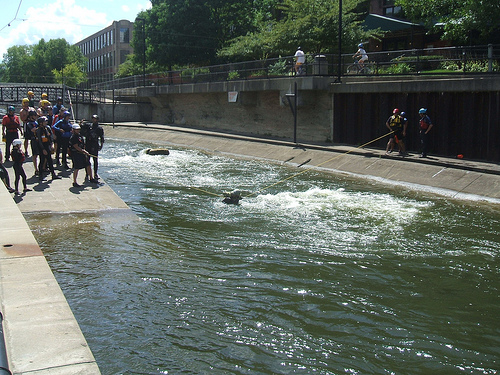If all participants are safe, waiting for low water may be a viable option
If it is just a boat pin and you are on a dam controlled stream like the Savage River in Maryland, tie a tag line with a tensionless hitch to a tree or other suitable anchor and wait for the water to drop. It should be much easier to retrieve at low water.
Self rescue
If you happen to broach on a boulder, don't panic. If you lean hard onto the boulder you will keep your cockpit downstream and it will not be filling with water. The next step is to carefully rock the boat back and forth hoping to catch the main current. Most of the time, this will free the boat. In an end to end pin, if the current isn't too strong, you may be able to push off with your paddle blade to free yourself. If the boat starts to fold, pop the skirt and get out ASAP! In most vertical pins, you will need some assistance. If heads up, stay calm so you don't flip the boat and blow your whistle for attention. If you have a waist or pocket bag, you may be able to toss it to someone on shore if this doesn't cause you to lose stability. If heads down and rolling doesn't work, get out of the boat ASAP, why wait for worse luck to happen like a wrap.
Cinch line techniques may be helpful for pinned gear
One advantage of a cinch line over a stabilization line is sideways control of the boat once freed. The same is true for a trapped victim but you need to weigh this benefit against the high potential for injury due to squeezing. Cinch lines can also be used to turn/twist a boat so the cockpit is no longer filling with water. The Steve Roberts Rope Trick is an interesting example of this technique.
Stabilization line to support trapped victim
 A stabilization line crosses the stream or chute and allows the victim to rest their chest against it - keeping the head up. This line buys lots of rescue time. Water currents are often quite strong and too difficult to sustain an upright position even with a paddle to prop yourself up with. A stabilization line is far safer than a cinch line.
A stabilization line crosses the stream or chute and allows the victim to rest their chest against it - keeping the head up. This line buys lots of rescue time. Water currents are often quite strong and too difficult to sustain an upright position even with a paddle to prop yourself up with. A stabilization line is far safer than a cinch line.
When setting a stabilization line, most rescuers forget how powerful water is and run the line straight across the river. This establishes a strong vector pull which is very hard to maintain. Once the line is in place, both sides should walk back upstream to eliminate the vector pull. You can also use trees to carry the load via a tensionless hitch. Just wrap the rope a couple of times around the tree. Friction will do the heavy lifting and it is still very easy to pay out line if desired.
Page 2 of 4
